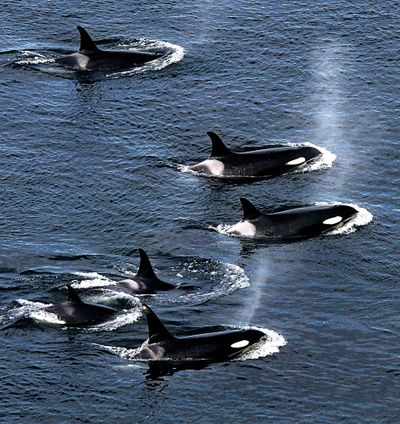Orcas are eating great white sharks’ livers off South Africa’s coast

In 2017, five great white shark carcasses washed ashore in four months in South Africa. Four of them were missing livers, and one had its heart removed.
Now, scientists have zeroed in on the suspects: a pair of male orcas named Port and Starboard with a taste for energy-rich shark liver.
The attacks have continued, and the pair are probably not the only orcas terrorizing great whites in the area. A study published in the peer-reviewed African Journal of Marine Science on Wednesday found that orcas are displacing great whites as the top predator in Gansbaai, a popular shark viewing destination about 75 miles east of Cape Town. With great whites increasingly absent, smaller predators can multiply unchecked, threatening prey species and destabilizing the entire ecosystem.
Similar responses when a new top predator arrives in a land ecosystem have been well-studied, but documenting the same phenomenon in the ocean is rare, according to Alison Towner, a marine biologist at the Dyer Island Conservation Trust who led the study.
“We now have direct evidence that one of the oceans largest apex predators completely displaces the another, and it is the first time in the world that white shark carcasses have been available for scientific examination directly after being hunted by Killer whales,” she wrote in an email to The Post.
Researchers launched the study in 2017 after performing necropsies on the likely victims of Port and Starboard, identified by their distinctive dorsal fins.
The waters off Gansbaai are normally teeming with sharks – in the months leading up to the 2017 attacks, scientists were logging close to seven sightings per day. But following the orca attacks, sightings immediately plummeted to 1.17 per day on average for the next six months. The average remained under two sightings per day for 2018 and 2019.
Before 2017, there had only been two periods since data collection began that great whites had not been observed for a week or more, a week in 2007 and a three-week stint in 2016. In 2019, scientists were averaging almost 10 weeks between sightings.
The rapid departure and prolonged absences – which lengthened as sightings of orcas went up – led the researchers to conclude that fear of the larger predators was probably driving the great whites away from those waters.
Orcas can grow to 50% than great whites, and a previous study showed that they displaced great whites off the coast of San Francisco.
But they had never been documented doing so off South Africa, according to the study published Wednesday.
The researchers likened the great whites’ behavior to wild dogs in the Serengeti in Tanzania, which abandon territory for the long term when lions move in.
The study also examined how the ecosystem responded to the missing great whites. They warned that it could lead to a trophic cascade, when the decline or disappearance of one level of the food web destabilizes the entire ecosystem.
“Ecology is a balance,” Towner wrote. “Remove sharks at the top and everything is disrupted, smaller predators dominate and the system can potentially collapse or certainly some species within it.”
In the absence of the great whites, smaller bronze whaler sharks moved into the territory for the first time, a sign of the rapid effects it could have lower on the food chain, researchers said.
In Gansbaai, great white sharks keep the local Cape fur seal population in check. Without a predator to fear, they will be able to prey on endangered African penguins or gorge on the small fish the penguins rely on.
The researchers considered alternative explanations for the great whites’ absence, such as sea surface temperatures and fishing, but neither could explain the “sudden localized decline” at Gansbaai. In Mossel Bay, another area frequented by great whites roughly 200 miles to the east, the orca pair was not seen and shark sightings remained stable.
The orcas may have been drawn to the area by a decline in prey elsewhere in their territory, according to the study. Scientists are examining whether changing conditions offshore linked in part to climate change are driving orcas out of their normal hunting grounds, according to Towner.
Though great whites are becoming more prevalent in certain areas, such as off the California coast, their overall population remains fragile and the emergence of a new predator is concerning, according to the researchers.
Towner said the study serves as a warning sign of more ecological damage to come.
“[It’s] almost as if the science cannot keep up with how rapid the ecology is changing,” she said. “The evidence is there, it needs to be taken into account by policy makers to [to avoid] the situation escalating completely beyond help.”